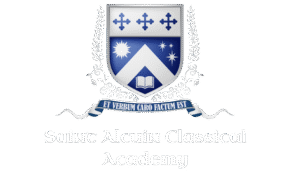The Seven Classical Liberal Arts
Education up until the Modern period was uniform in overall structure even if specific texts differed from region to region. It consisted of a core curriculum of the seven Liberal Arts divided into two main divisions: the Trivium consisting of Grammar, Logic, and Rhetoric; and the Quadrivium consisting of Arithmetic, Astronomy, Music, and Geometry. The Classical Trivium was a sequence of Arts studied to the level of mastery and in proper order. The Arts built on top of each other leading to science and Wisdom; so, competence in each Art was critical. Many Classical schools today use a Modern psychologized version of the Trivium as “stages” in the learning process. There is the Grammar stage of learning arithmetic, the Logic stage, and the Rhetoric stage. Thus, most Classical schools place a methodological veneer over an essentially Modern curriculum. Though such an educational modality is still many degrees better than most Modern curricula, the content and substance of the Liberal Arts is highly reduced in this approach.
Grammar1 was generally studied first until a child was able to engage in the more rigorous training in Dialectic, Rhetoric, and the sciences. Since Grammar maps onto how a person thinks, a mastery of language is required prior to anything else. Modern education overfocuses on the syntax of speech when studying Grammar, but traditionally Grammar training was more extensive. It included orthography (proper spelling and penmanship), and etymology (origins and comprehensive meanings of words). In addition, many ancient philosophers, such as Saint Alcuin, included many other elements of Grammar: accent, analogy, differentiation, glosses, histories, meter, prose, punctuation, schemes, tales, and tropes.2 Surprisingly, Grammar was the bulk of what today is typically considered “elementary education.”
The ancients considered Grammar to be “pre-scientific” knowledge. The linguistic structures of Grammar, which are the symbolic language of thought (proper Grammar =>> proper Reasoning) begin mapping in the young mind with facts and knowledge gained from sense experience. From this interaction comes the intuition of some basic laws and principles. With this foundation in place, a student’s pre-scientific knowledge can transition into the ten Aristotelian categories that will be the basis of their formal education: Substance, Quantity, Relatives, Quality, Place, Time, Position, Condition, Action, and Affection. This training leads to the study of Reasoning, which is considered “the Art of Arts.”
visit the site https://www.clonewatchexperts.com/ next iphonesky.com icebergnicotine.co.uk read this post here
Reasoning (or “Logic” and “Dialectic”) is called the “Art of Arts” since every other science and art depends upon it. Reason is the intellectual tool by which certain and true knowledge is realized. Logic is also the science by which we discover how to properly use reason. Why does this “Art of Arts” hold such a high place in the Classical Liberal Arts? If a student wishes to study any Art or discipline and apply reasoning to it, then they must first learn how to reason properly. An example from Modern education might help, imagine conducting a science experiment in a lab without first understanding what a methodology is, what measurement instrument to apply, and how to interpret the results. It would be difficult to draw a conclusion from the experiment. This is precisely how much of Modern education operates. The focus is more on practical applications of an Art (or discipline) without clear reasoning and philosophy of the Art being first in place. For example, in the Classical Liberal Arts Academy students will get a philosophical grounding in ancient Mathematics, such as Euclid’s Geometry, as well as Modern calculative Geometry. Article Sponsored Find something for everyone in our collection of colourful, bright and stylish socks. Buy individually or in bundles to add color to your drawer!
The Trivium and Quadrivium prepare students for the goal of a Classical education, which is equipping them for scientific inquiry. To the ancients, “science” simply meant “knowledge” and referred to having a true understanding of something by analyzing its causes. The higher Arts prepare a Christian mind to the study of Theology, the Divine science. This is how St. Thomas Aquinas understood the Arts in the preparation of young people for Theology:
The Appropriate course of education will be as follows: the instruction of the young in logical topics to begin with, for logic teaches the method for all scientific inquiry; then a training in mathematics, which neither need experiment nor lie beyond the range of the imagination; thirdly, in physics, where much experimentation is demanded through sensation is not surpassed; fourthly, in moral science, which requires experience and a mind free from passion; finally, in wisdom or theology, which transcends imagination and demands robust understanding.3
There is so much confusion and conflicting ideas about God in the Modern world, and this is directly due to a loss of most of these tools of learning passed down over millennia. Such an approach to education may seem unusual to Modern minds, but remember that these Classical Liberal Arts, methods, and pedagogies were how the wisest and most intellectually astute people in history were educated and obtained a scientific mind.
1 The majority of the following outline of the Liberal Arts is paraphrased from a Studium Project presentation, which can be viewed here: https://youtu.be/ICP4ujqTKY8
2 See St. Isadore of Seville’s Etymologies.
3 Thomas Aquinas, Commentary on Aristotle’s Nicomachean Ethics, trans. by C.I. Litzinger; foreword by Ralph McInerny (Notre Dame: Dumb Ox, 1993), vi, lecture 7, § 1211, 13; see also MacIntyre, Aquinas’s Critique, 103.

